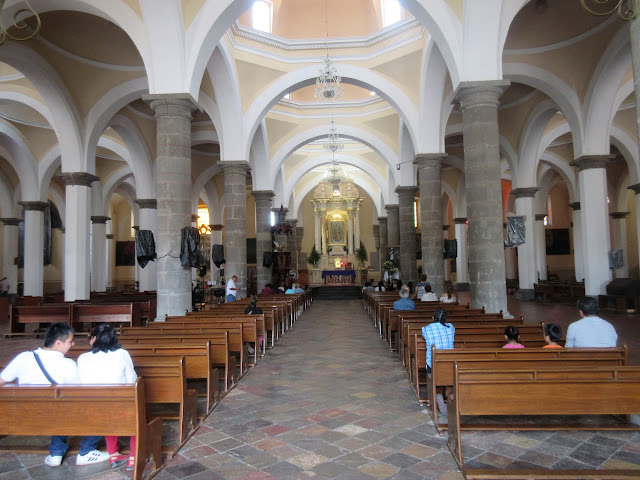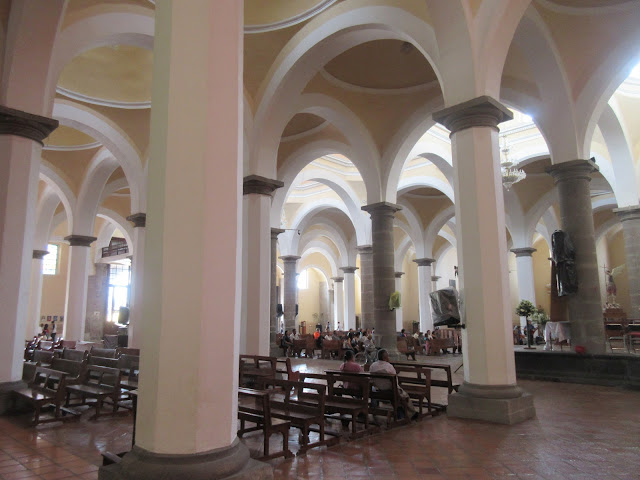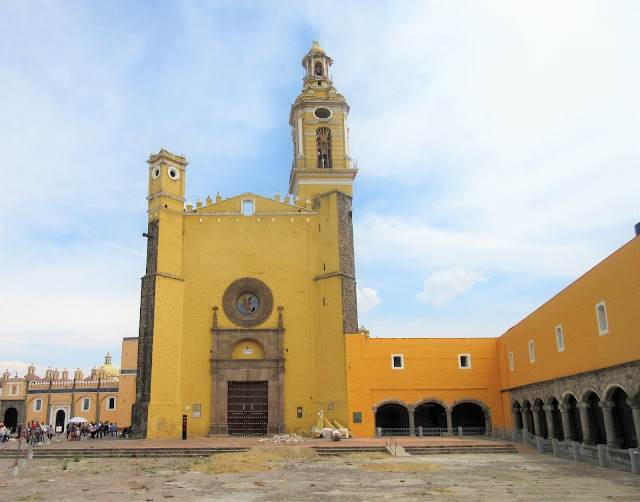March 18, 2018
Our last day with our guide Arnold Pedroza in Mexico was very full. The map below shows our starting point, Mexico City, on the left. The two black circles mark the two Volcanos Popo and Ixta (which we had already visited), and the three red circles on the bottom right are our three destinations of the day: Huejotzingo, Cholula, and Puebla.
Our first stop was Huejotzingo (see my last post), so our next stop was Cholula, population 120,000. Arnold told us it is the oldest still-inhabited city in the Americas, having been populated since the 2nd century BC.
It is said that Cholula has 365 churches, one for every day of the year or, alternately, one for every pre-Hispanic temple that used to be in the area. The truth is there are only a tenth that many churches--37 (or 159 if you want to be generous and include all the small chapels on the local haciendas).
There were two main sites we were interested in: The San Gabriel Franciscan Monastery and the Nuestra Señora de los Remedios (Our Lady of Remedies) Church.
We started at San Gabriel, built in the 1540s on top of a destroyed temple to Quetzalcoatl. The atrium, aka courtyard, enclosed by the monastery walls is huge.
Two churches are part of the monastery. The Capilla Real (Royal Chapel) was built in the 17th century, replacing the original chapel built here in 1540. I loved the brilliant gold color of this and the other churches we saw in Cholula.
The interior is very unique. There are 49 cupolas supported by columns and the walls are mostly plain, making it look much more like a mosque than a cathedral.

The main altar, however, is adorned with a painting of the Virgin of Guadalupe, which makes it unmistakably Catholic.
These two might be popes or bishops? I'm not sure.
And what about these two gentlemen? They remind me of Athos, Porthos, and Aramis, the Three Musketeers. (Except, of course, one is missing.)
I do think this window with the dove is really beautiful.
In the ambulatory, or the curved area behind the choir, four large paintings illustrate the story of the Virgin of Guadalupe. Even during the apparition, she faithfully holds the same pose.
On our way out, we passed this beautiful font, carved from a single stone in the 16th century.
. . . but the front is a bold sunflower yellow.
Note the rubble to the right of the front door in the photo above. Here is a close-up view. This is damage from the 2017 earthquake.
A beautiful stained glass window above the main entrance also looks like it suffered in the earthquake. I'm surprised any of the glass survived!
The bell tower was also damaged by the earthquake, but it looked like the repairs were mostly complete.
I don't have any pictures of the interior because a crowded mass was occurring, and there was no way to take pictures without being offensive. Luckily, I could borrow a photo from Wikipedia. Isn't it beautiful?
 |
| Photo from here |
Bob's favorite part of our visit to to San Gabriel Monastery has to have been the vendors in the courtyard. Can you identify any of these dried foods? Well, there are nuts, seeds, sweets, and chapulines. What are chapulines?
Chapulines are grasshoppers that have been toasted and flavored. Yep, exactly the kind of treat Bob likes. And by the way, part of the flavoring is sometimes made from Maguey worms, or the caterpillars found on agave plants. Makes your mouth water, doesn't it?
Of course, Bob had to have some. He bought a bag of them and saved (and savored) them for his lunch.
My purchases in the courtyard were tame by comparison. I bought this tasty pastry--much better than Bob's choice, right?
I also bought a bunch of colorful cornhusk flowers (which only cost 30 pesos, or less than $1.50).
The base of this pyramid is twice as big as the base of the enormous Pyramid of the Sun at Teotihuacan and three times greater than that of the Great Pyramid of Giza in Egypt. In fact, the Guiness Book of Records notes that this is the largest monument ever constructed anywhere in the world. It's total volume of about 157 million cubic feet is almost twice the volume of the Great Pyramid of Giza, which is 88.2 million cubic feet. (Okay, okay--Giza is taller. It is 481 feet tall compared to the Great Pyramid of Cholula at 217 feet tall).
This model shows multiple layers of pyramids constructed between about the 3rd century BC through the 8th century AD. At its peak, 100,000 people lived in Cholula. Amazing. So far, only three of the six pyramids have been studied.
What stuns me is that after centuries of work on this monumental pyramid, it was abandoned after the 8th century, even though it retained its religious significance. By the time Spain conquered Mexico, it was covered with growth. No one really cared about what was underneath until 1931, which is when archaeologists began tunneling into the hill. By the 1950s, they had dug five miles of tunnels that wound through the pyramids, revealing stairways, platforms, and altars.
By the way, when Cortés and his men entered Cholula in 1519, they massacred about 3,000 people in a single hour, which was 10% of the city's entire population at the time, and they systematically leveled many of the religious structures--but not this one because they didn't know it was there.
This drawing from Wikipedia shows what the pyramid looked like at its prime.
It is possible to take a tour of the network of tunnels, but the line was long, the day was short, and we still had one more city to visit. We elected to move on to Puebla, but some day we want to go back to Cholula to take that tour and visit La Iglesia de los Remedios.
We did walk by the one part of the pyramid that has been excavated/reconstructed, a three-level stone stairway known as "Building F," seen below from left of center and right of center. Just a small part of the full pyramid, it is still huge.
We also passed by these performers.
Off to Puebla!



















































Cholula is one of my favorite towns.
ReplyDeleteI had never heard of Cholula and did not know about the pyramids. Sounds like.a great. I would go just for the grasshopper tacos.
ReplyDeleteGee, you must be related to Bob.
DeleteJohn, I agree, I also loved Cholula. The grasshoppers weren't bad. I've eaten far worse.
ReplyDelete